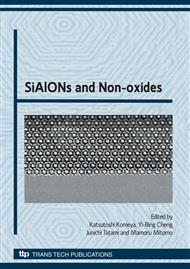p.73
p.77
p.83
p.87
p.91
p.95
p.97
p.99
p.103
Controlled Crystallisation of a Y-Si-Al-O-N Glass Typical of Grain Boundary Glasses Formed in Silicon Nitride-Based Ceramics
Abstract:
This paper provides an overview of the crystallisation of an oxynitride glass likely to remain in a silicon nitride ceramic following firing. The crystallisation process was studied using both differential thermal analysis (DTA) and separate isothermal heat treatments in a tube furnace under nitrogen. The activation energy for the crystallisation process was determined by DTA. The nucleation temperature, Tg + 40°C, which corresponded to the maximum volume fraction of crystalline phases, agreed closely with the optimum nucleation temperature of Tg + 35°C, found from DTA. The optimum crystal growth temperature was observed to be 1210°C and yielded the - and -polymorphs of yttrium disilicate. Heat treatments at other temperatures indicated the development of phase assemblages which contained different polymorphs of yttrium disilicate as well as silicon oxynitride. Not all of the polymorphic transformations of yttrium disilicate were observed by DTA unless some crystallisation exotherms were deconvoluted, indicating that DTA analysis of the crystallisation of complex systems requires careful interpretation. It is, however, possible to simplify the system by substituting some yttrium by lanthanum. This stabilises the -polymorph of yttrium disilicate. The activation energy for crystallisation was observed to be similar to that for viscous flow of Y-Si-Al-O-N glasses.
Info:
Periodical:
Pages:
91-94
Citation:
Online since:
December 2008
Authors:
Price:
Сopyright:
© 2009 Trans Tech Publications Ltd. All Rights Reserved
Share:
Citation:


